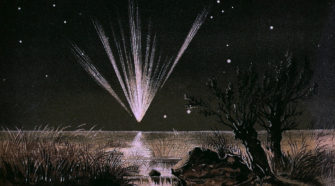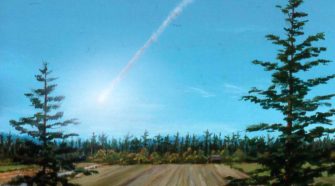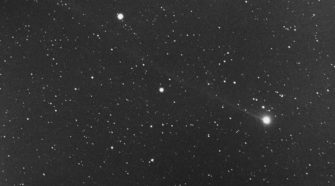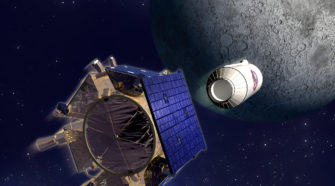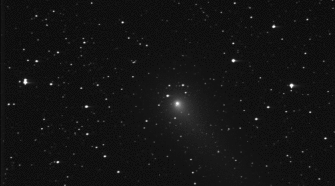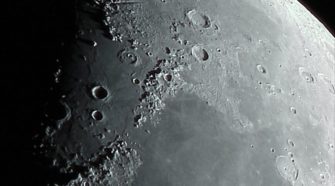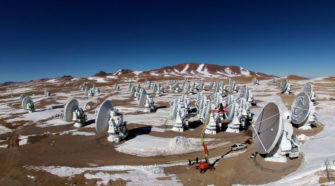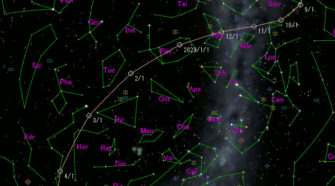Ice and Stone
Comet of the Week: Tebbutt 1861 II
Perihelion: 1861 June 12.01, q = 0.822 AU Two of the brighter comets of the latter half of the 19th Century were discovered by an Australian amateur astronomer, John Tebbutt, who for four decades essentially ran a one-man astronomical clearinghouse from his private observatory near Windsor, New South Wales. In addition to numerous astrometric observations …
Special Topic: The Tunguska Event and Other Recent Impacts
During the early morning hours on Tuesday, June 30, 1908, at around 7:17 A.M. local time, “something” entered the earth’s atmosphere near the Pacific coast of Asia, traveling northwestward. A few km above the surface of a largely uninhabited region of central Siberia, near the Stony Tunguska River some 90 km north-northwest of the village …
This Week in History: June 21-27
JUNE 22, 1978: U.S. Naval Observatory astronomer James Christy discovers Charon, Pluto’s first-known moon. Charon, the discovery of which would be confirmed with a series of transit and occultation events between it and Pluto that began in 1995, provided a major step in our understanding of Pluto’s size and physical nature. Pluto, its system of …
Comet of the Week: 2P/Encke
Perihelion: 2020 June 25.85, q = 0.337 AU In the early 19th Century the idea that comets might return to the inner solar system on a regular basis was still a bit of a novelty. This had been successfully demonstrated by the British astronomer Edmond Halley when the comet that now bears his name returned …
Special Topic: Orbits and Future Returns
“Ice and Stone 2020” participants have undoubtedly noticed that I have often discussed how this-or-that comet or asteroid will be returning to the inner solar system or passing by Earth at some point in the future, and perhaps have wondered how such things are determined. In principle, the processes by which such events are calculated …
This Week in History: June 14-20
JUNE 14, 1770: The renowned French comet hunter Charles Messier discovers a moderately bright comet in Sagittarius. 2½ weeks later this comet passed just 0.015 AU from Earth, the closest confirmed cometary approach to Earth in history. The comet, named after Swedish mathematician Anders Lexell, who computed its orbit, was later perturbed into a much …
Comet of the Week: LINEAR C/2001 A2
Perihelion: 2001 May 24.52, q = 0.779 AU At the beginning of the 21st Century the discovery of comets and near-Earth asteroids was dominated by the first of the comprehensive sky surveys, the LIncoln Near-Earth Asteroid Research (LINEAR) program run by MIT’s Lincoln Laboratory and based at White Sands Missile Range in New Mexico, that …
Special Topic: Lunar and Planetary Impacts
Ever since the Italian astronomer Galileo Galilei turned his primitive telescope towards the moon on November 30, 1609 and saw them for the first time, we’ve known that the moon is covered with craters. These come in all sizes, from very large ones several hundred km across down to meter-size and smaller. For a long …
This Week in History: June 7-13
JUNE 7, 2013: A team led by Dutch astronomer Nienke van der Marel announces their discovery of a planet-forming – and comet-forming – disk of material surrounding the young star Oph-IRS 48 in the constellation Ophiuchus, using data obtained with the Atacama Large Millimeter/submillimeter Array (ALMA) telescope in Chile. An ALMA image of this disk …
Comet of the Week: PANSTARRS C/2017 K2
Perihelion: 2022 December 19.67, q = 1.797 AU I’ve hinted in some of the earlier presentations of “Ice and Stone 2020” that, for the past few years, we have been in a slow period when it comes to bright comets. Indeed, for “Great Comets” – discussed in a previous “Special Topics” presentation – the most …

